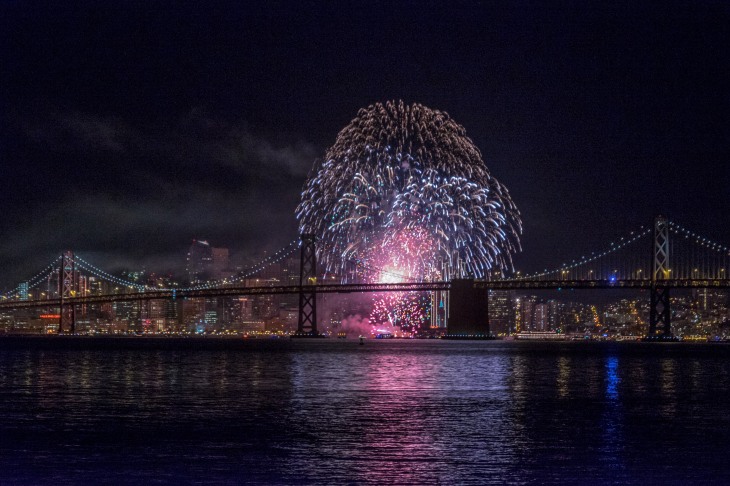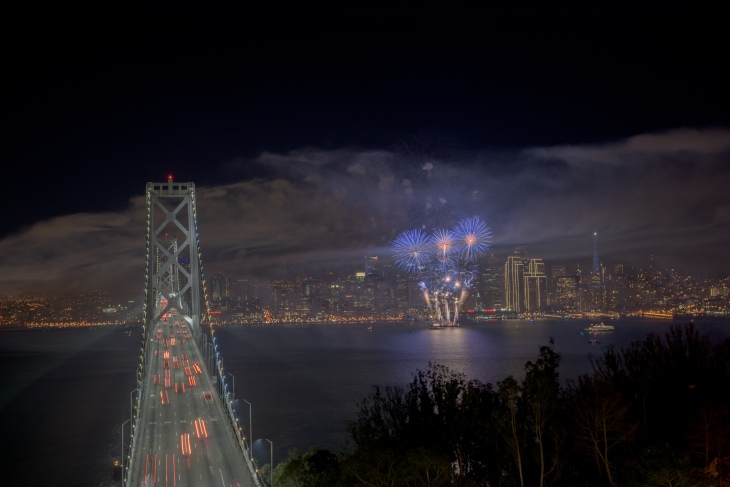
Vantage point, plan B during NYE 2015. (typical pyrotechnic capture)
Fireworks that is. Strange, but after spending 5 years in China, I finally got the opportunity to shoot fireworks … in San Francisco, CA no less! Go figure, right? Fireworks were invented in China thousands of years ago and my many quests in seeking out those awesome flowering gunpowder blossoms throughout China, I came away greatly disappointed. I could never time the few opportunities right and when I did, it was so crowded with gazillion people, that I couldn’t get close enough to get a full view of them let alone photograph them either.
With a little luck, one of the most senseless of American sports, and probably the most popular, is (American) Football. (American) footballers, please don’t hate – I just don’t particularly like where the sport has gone in the last 15 or so years, but that’s just my

Vantage point, plan B during NYE 2015. (typical pyrotechnic capture)
opinion … read on. It just so happens the championship game was being held about an hour south of San Francisco in Santa Clara. Seeing as Santa Clara is neither here nor there (in between San Francisco and the famed tech capitol, Silicon Valley), the NFL decided to keep all of the festivities, except for the game itself of course, in the City by the Bay. Part of the pre-game events, amongst others was a weekend kickoff which included … you guessed it … Fireworks! Since my return, I wanted to shoot NYE fireworks from a particular location

Vantage point, plan B during NYE 2015. (typical pyrotechnic capture)
that included the Bay Bridge. So, just before the stroke of midnight, I began my quest only to be thwarted by traffic on the approach to the bridge. Ditching out of traffic at the last exit before being stuck past midnight (on the bridge), I head out to see if Plan B was a good option … actually, it was my only option. With 15 mins to spare, I get lucky on location.
I still, however, hadn’t satisfied my location quest for fireworks across the San Francisco Bay until the other day. Thanks to the Superbowl, I finally had my chance to shoot pyrotechnics from my much sought after and elusive location.
What I’ve learned in photography is that every genre has a price to pay if you want to capture what you have in mind – that price is time. Time in learning (the technical Time in planning. Time in researching. Time is getting there and time in waiting. The wait is typically long (often quite boring I might add). When “that time” comes, you need to act and react quickly to the events of the ‘now’. Whatever it is … a sunrise, a sunset, lights beams that skate across a room or surreal sky, a passing light that sheds side lighting that wraps perfectly around your subjects face – all require your undivided and full attention to the artistic nature of photography. Using the hardware (camera and lens) as a tool to create
tool to create
your art, you must first and foremost have a good command of the technical aspects and the relationships between key elements of your kit. Having studied, experimented, failed and persevered though more experimentation, it affords you to take what most will do and tweet it to create something unique. Be it original or upon seeing out in the photography world, you still need to learn and practice it.
I like to experiment. In fireworks, it’s all about getting just the right amount of light to hit the sensor as to not blow out your highlights yet dragging the shutter enough to get that light trail while the explosive bloom begins its descent downward. Timing is everything like most things and starting your image capture is critical. Once you’ve dialed this in, it’s ju st a matter of making captures after captures. I, however, am just not satisfied here and started to experiment with a slightly different take on capturing fireworks – in camera, of course! If you look close enough at some of these captures on this page, the blooms are not quite the usual light trail streaming evenly downwards, they appear more funnel-like – a definite unique twist. I first saw this on the internet and practiced and experimented to see if I could replicate it. Whatever technique you use to capture pyrotechnics, shutter speed should be your first setting to consider. Too short and you don’t get the nice blooming effect from the explosion (and your ISO will be cranked up a little too high). This will be adjusted from your first few frames. Next is ISO, which is essentially the first setting to determine – start at 100 or 200 and work your way up accordingly, keeping in mind that lower is better for overall image quality yet high enough to achieve your desired results. Then, of course there’s your aperture or F-stop which could be anything that support the previous 2 settings – try f5.6 for starters.
st a matter of making captures after captures. I, however, am just not satisfied here and started to experiment with a slightly different take on capturing fireworks – in camera, of course! If you look close enough at some of these captures on this page, the blooms are not quite the usual light trail streaming evenly downwards, they appear more funnel-like – a definite unique twist. I first saw this on the internet and practiced and experimented to see if I could replicate it. Whatever technique you use to capture pyrotechnics, shutter speed should be your first setting to consider. Too short and you don’t get the nice blooming effect from the explosion (and your ISO will be cranked up a little too high). This will be adjusted from your first few frames. Next is ISO, which is essentially the first setting to determine – start at 100 or 200 and work your way up accordingly, keeping in mind that lower is better for overall image quality yet high enough to achieve your desired results. Then, of course there’s your aperture or F-stop which could be anything that support the previous 2 settings – try f5.6 for starters.
I love educating folks who genuinely have a desire to improve themselves – not just to get any particular shot. When people ask, “What are your settings?” What most are really asking is “How do I get the shot?”. One setting may get you THAT shot at that moment, but if you don’t know why it is the way it is (camera settings) and how to adjust on the fly and know what it’ll take to replicate it the next time (and adjust even more), then you truly don’t have a solid understanding how a camera works. I mainly shoot in Manual Exposure mode instead of any of the program modes mainly because it affords me to not only control my output, but constantly challenges me to always to be aware of what I’m doing.
As with most, I am a perennial student and am always learning and practicing my craft. I had 6 minutes to do so this one evening (the other 6 minutes were spent capturing the ‘usual’ way of making images of fireworks.). I found myself switching back and forth with the 2 very different techniques; only through an understanding of my gear and how to manipulate it was I able to capture anything worth keeping – I consider myself lucky this evening … enjoy.
